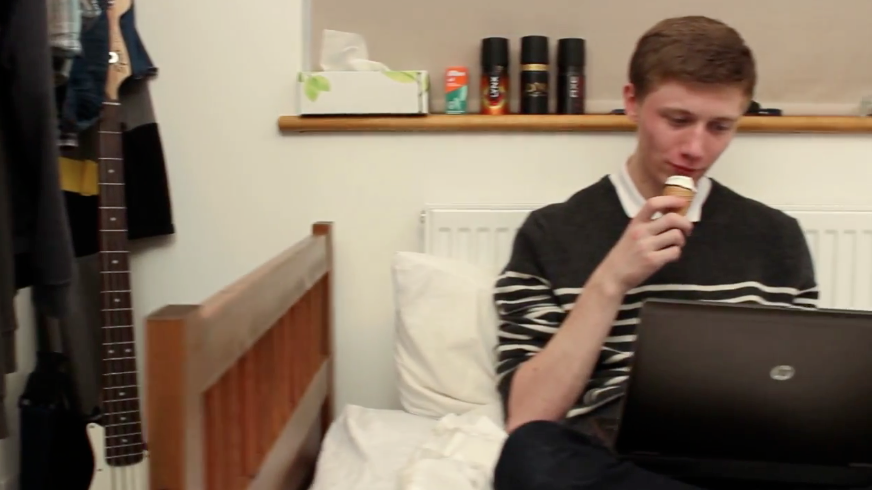Michael is a coming-of-age, teen, romantic comedy. I have chosen to
answer this question in four parts Genre, Narrative, Form and Style.
Genre
We conformed to the majority of conventions because we wanted our audience to be able to easily recognise and relate to our film opening. Common genre conventions:
We took influence from various characters to create our characters.
Michael
Michael
 |
| Michael is an awkward British teenager who wants to get his girlfriend back after she breaks up with him |
Characters who influenced us:
| Scott Pilgrim (Scott Pilgrim vs The World) Scott is an awkward 22 year old who is in a band and is slightly hopeless with girls |
| Oliver Tate (Submarine) Oliver Tate is an awkward British teen, who spends a lot of the film chasing after his love interest Jordana |
| Charlie (The Perks of Being a Wallflower) Charlie is a socially anxious, american teenager who makes new friends and fall in love with Sam |
| Tom (500 Days of Summer) Tom gets extremely upset when his girlfriend Summer breaks up with him |
Lara
Characters who influenced us:
 |
| Lara is a self-centred British teenager, she leaves Michael for Brad |
Characters who influenced us:
| Regina George (Mean Girls) Regina George is vain and self centred, she is the school princess |
 |
| Lindsay (Angus, Thongs and Perfect Snogging) Lindsay is a fickle, British Teenager. She is admired by most of the school but is also the school bully |
Form
To create our film opening we researched the form institutions use and made sure we used similar form.
Style
Titles:
We chose to use integrated titles in a simple sans serif font, taking influence from similar films. We used this because we felt it was aesthetically pleasing and suited the genre; British coming of age films use sans serif because it is not stylised like the films, which usually aim to be naturalistic.
Examples from Michael:
We chose to use integrated titles in a simple sans serif font, taking influence from similar films. We used this because we felt it was aesthetically pleasing and suited the genre; British coming of age films use sans serif because it is not stylised like the films, which usually aim to be naturalistic.
Examples from Michael:
 |
| Integrated titles disappear and change behind Michael |
Similar films which used Sans serif fonts:
 |
| Submarine (2010) |
Submarine is a British coming-of-age film following Oliver Tate which influenced Michael. Submarine uses Sans Serif to offset it's quirky tone. |
| About Time (2013) |
 |
| Scott Pilgrim VS The World (2010) |
Scott Pilgrim VS The World follows Scott Pilgrim as he tries to win Ramona Flowers, it was one of our biggest influences for Michael. It uses Sans Serif font to follow the comic book and video game theme running through the film.
Films which use integrated titles:
We used integrated titles because we wanted to develop and practice new skills in using After Effects, they are visually pleasing and they don't detract from the scene. During focus groups with our target audience we found that they found them interesting and added something to our opening.
 |
| Scott Pilgrim Vs The World (2010) Integrated titles serve as a transition from the scene into the title sequence and look good visually |
 |
| Zombieland (2009) Integrated titles help the audience to focus on what is happening in the scene because the titles are part of it. |
Grading and Colour
We chose to grade our film opening to make it look natural and realistic; grading served as a way to improve and bring up our shots.
Grading in Michael:
Michael is a naturalistic film about realistic characters. We wanted to reflect this in the grading by using natural colours and tones and high key lighting.
Similar grading in About Time:
About Time is also a film about realistic characters and emphasises this through grading.
The naturalistic grading that is typical of independent films is contrasted by big hollywood movies using vibrant grading. The vibrant grading reflects the fun, hyper-realistic tone of films such as superhero film The Amazing Spider-man and romantic comedy That Awkward Moment.
We chose to grade our film opening to make it look natural and realistic; grading served as a way to improve and bring up our shots.
Grading in Michael:
Michael is a naturalistic film about realistic characters. We wanted to reflect this in the grading by using natural colours and tones and high key lighting.
 |
| Shot from Michael |
 |
| The grading in Michael uses blacks, browns and beiges |
Similar grading in About Time:
About Time is also a film about realistic characters and emphasises this through grading.
 |
| About Time (2013) |
 |
| The Grading in About Time uses blacks, browns and beiges |
The naturalistic grading that is typical of independent films is contrasted by big hollywood movies using vibrant grading. The vibrant grading reflects the fun, hyper-realistic tone of films such as superhero film The Amazing Spider-man and romantic comedy That Awkward Moment.
 |
| That Awkward Moment (2013) |
 |
| The Grading in That Awkward Moment uses pinks, reds and blacks |
Narrative theory
Todorov:
We used Todorov's narrative theory as a base for our narrative but did not conventionally use all aspects of it. We started in disequilibrium to engage our audience from the start of the film and added a secondary disruption to increase the conflict and drama in Michael.
Our Narrative is similar to that of Freaky Friday's:We used Todorov's narrative theory as a base for our narrative but did not conventionally use all aspects of it. We started in disequilibrium to engage our audience from the start of the film and added a secondary disruption to increase the conflict and drama in Michael.
 |
| Flow chart explaining the narrative of the entire film compared to Todorov's narrative theory. |
 |
| Freaky Friday is a film that was successful worldwide, we hope to have the same effect on audiences |
Specific Narrative Techniques:
Ellipsis - When Michael runs away from Lara we do not show the journey he takes when running home. We cut from him running away to him arriving home. The audience fill in the gaps and assume he has taken the journey home.
 |
| Michael running away from Lara |
 |
| Michael arriving home |
Propp:
We conformed to Propp's character theory but did not use all 7 character functions:
Hero - Michael
Villain - Brad
Princess - Lara
Helper - Tris
We did not include the donor, dispatcher or false hero because introducing too many characters can be confusing for an audience. Also not all of the character functions worked with our story eg. we did not use a Dispatcher function because Michael decides to get Lara back by himself.
Levi-Strauss:
We used Levi-Strauss's theory that conflict is set up by binary opposites in our opening.
The binary opposites we set up were:
- Michael vs Brad
- Michael vs Lara
- Good vs Evil
- Happy vs Sad
We did this to create conflict which engages the audience and drives the plot forward.
Barthes:
We conformed to and challenged Barthes codes and signifiers theory.
Enigma Codes:
Our opening raised questions such as
- Why did Lara break up with Michael?
- Why is Lara going out with Brad?
- How will Michael react?
- What will Michael do to get her back?
- Will Michael win back Lara?
Enigmas intrigue the audience and make them want to keep watching to find the answers to the questions presented.
Action Codes:
We challenged the action code theory for comic effect because Michael's actions are unexpected
This makes our opening humorous and engaging for the audience.
Cultural Codes:
Where Michael lives and his room both contain cultural codes
 |
| This quiet street with semi-detached houses connotes suburban London |
| My Chemical Romance Poster (US Punk Rock Band) |
| Jimi Hendrix poster (US Rock artist) |
| One Direction Cardboard cutout (UK Pop Band) |
Symbolic Codes:
We showed that time was passing with a montage. An example of this is Edgar Wright's Comedy Hot Fuzz (2007):
We implied that Lara did not feel the same way about Michael as he did about her when pulled her hand away from his and rolled her eyes.
Semiotic Codes:
Michael crushing his ice cream shows his anger
 |
Michael crying shows his sadness
Conclusion
Our film opening conformed to the conventions, narrative form and style in most cases but sometimes we used unconventional techniques in order to entertain and shock our audience.





.jpg)





No comments:
Post a Comment